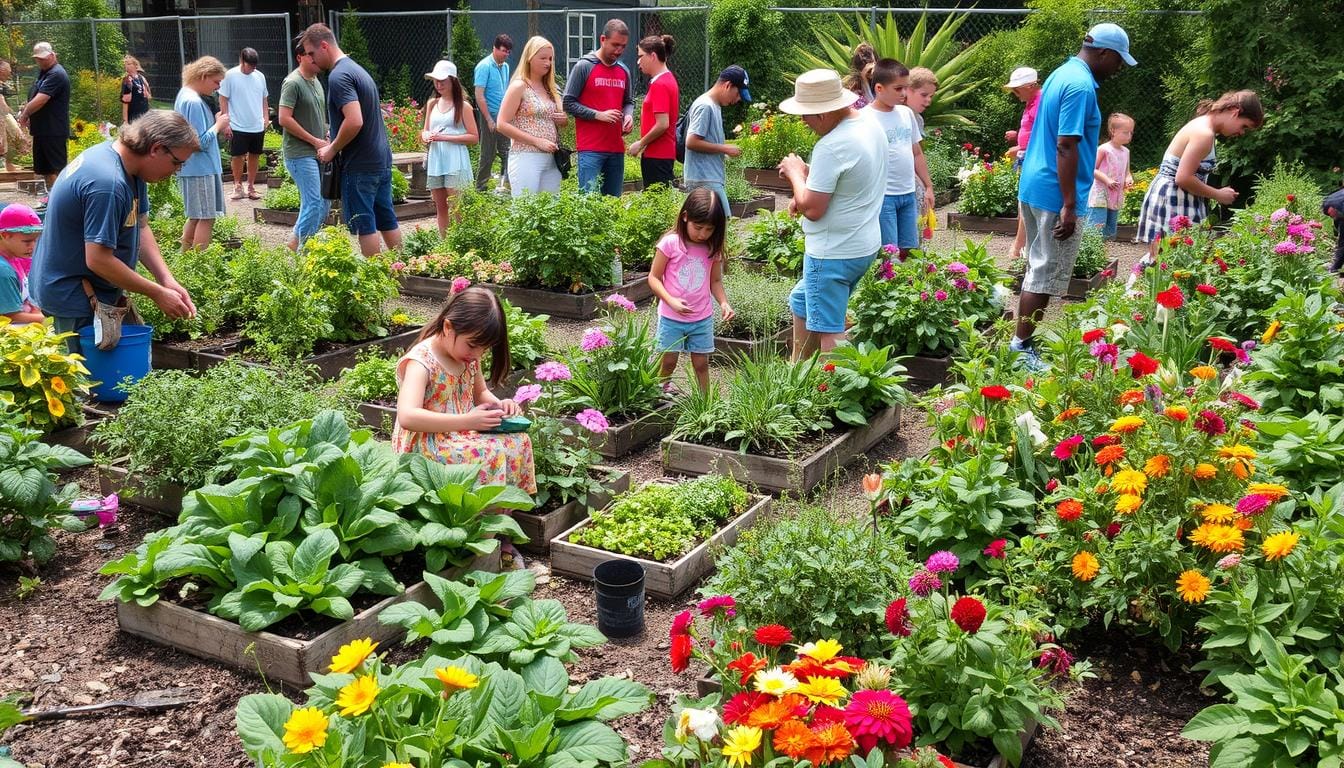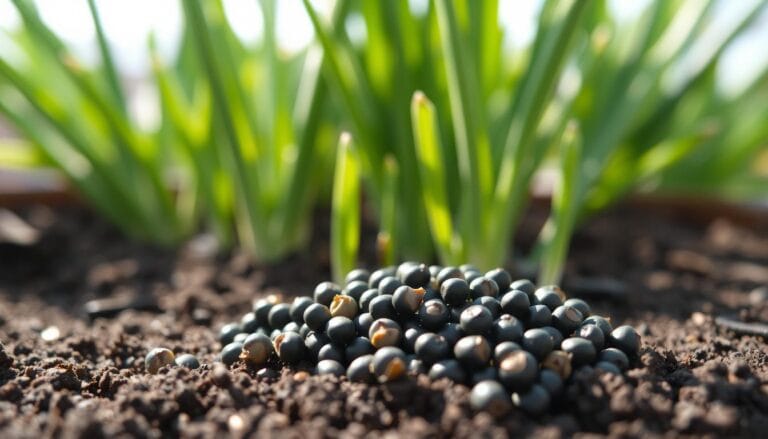How do people interact with horticulture in daily life?

https://www.greenornamental.com/role-in-kinship-in-horticulture/Have you ever looked at the colorful flowers in your neighborhood or the greenery on your way to work? Horticulture, the art and science of growing plants, is all around us. It’s not just about beauty; it’s also crucial for our health and community.
Think about the fresh veggies you eat or the joy of caring for a houseplant. Horticulture connects us deeply to nature. Whether you love gardening or just enjoy looking at beautiful landscapes, this article will show you how to interact with horticulture in your daily life. You’ll discover the many benefits that surround us.
Table of Contents
Understanding Horticulture and Its Role in Modern Life
Horticulture is the science and art of growing plants for our use and enjoyment. It’s all around us, from the food we eat to the plants in our homes and public areas. It’s a big part of our communities, both in cities and countryside.
Defining Horticulture in Everyday Context
Horticulture covers many areas, like arboriculture (tree care) and turf management (lawn care). It also includes floriculture (flowers and plants), landscape horticulture (outdoor spaces), and more. These areas help us have fresh food, green spaces, and beautiful environments every day.
Impact on Urban and Rural Communities
In cities, community gardens and edible landscaping give us fresh, local food. They also bring people together and connect us to nature. In rural areas, horticulture helps local economies, ensures food, and keeps traditional farming alive.
Benefits of Horticultural Integration
Adding horticulture to our lives has many benefits. It improves our health and helps the environment. Horticultural practices like organic farming and green spaces are good for our planet. Plus, caring for houseplants can make us feel better and reduce stress.
Horticulture is key in modern life, shaping our communities and protecting our planet. By exploring this field, we can create a brighter, more sustainable future.
Common Ways to Interact with Horticulture in Your Daily Life
Horticulture is all around us, from growing plants indoors to creating lush gardens. It’s a blend of art and science that enriches our daily lives. You can easily get involved with gardening tips, urban farming, and houseplants care every day.
Indoor plants are a great way to connect with horticulture. They bring nature’s beauty into your home. Caring for them, like watering and pruning, can be calming and fulfilling.
Outdoor spaces offer another chance to engage with horticulture. Whether it’s a small balcony or a big backyard, you can grow your own food. Gardening tips help you plant, weed, and harvest. Urban farming lets city folks grow their own food too.
Public green spaces are also a great place to enjoy horticulture. Parks, botanical gardens, and community gardens showcase plant diversity. You can learn, participate in programs, or volunteer.
| Ways to Interact with Horticulture | Description |
|---|---|
| Growing Indoor Plants | Caring for a variety of houseplants, including succulents, herbs, and edible crops. |
| Maintaining Home Gardens | Cultivating vegetables, fruits, or flowers in outdoor spaces like balconies or backyards. |
| Visiting Public Green Spaces | Exploring parks, botanical gardens, and community gardens to appreciate plant diversity. |
| Consuming Fresh Produce | Purchasing and incorporating locally grown or homegrown fruits and vegetables into your diet. |
Eating fresh, locally grown food is another way to connect with horticulture. You can buy from farmers’ markets, join CSAs, or grow your own urban farming. These gardening tips and houseplants care make your meals more enjoyable and healthy.
“Gardening is the art that uses flowers and plants as paint, and the soil and sky as canvas.” – Elizabeth Murray
By exploring these ways to engage with horticulture, you can grow a deeper love for nature. It improves your health and helps the planet. It’s a rewarding part of daily life.
Therapeutic Benefits of Gardening and Plant Care
Getting involved in gardening can greatly improve your mental and physical health. It has been shown to positively affect both your mind and body.
Mental Health and Stress Reduction
Gardening can lower stress levels by reducing cortisol, the stress hormone. It makes you feel happier and boosts your overall well-being. Gardening can even lower dementia risk by up to 36% and improve memory.
Physical Exercise and Motor Skills
Gardening is good for your body too. It improves motor skills, strength, and endurance. Activities like digging and planting help with these.
Being in the sun while gardening can also help. It lowers blood pressure and cholesterol. Plus, it boosts Vitamin D, which is key for strong bones and less chronic pain.
Social Connection Through Community Gardens
Community gardens help you feel part of a community. They encourage creativity and learning. School gardens, for example, help kids develop healthy habits and teamwork.
Therapeutic horticulture uses plants and gardening to help people. It reduces depression and anxiety. It also boosts mood and self-esteem.
“Proper care in gardening, including adequate watering and sunlight, is vital for plant growth and biodiversity.”
A recent study by UF/IFAS and UF College of Medicine showed gardening’s benefits. Participants saw better spine mobility and less anxiety. They also wanted to keep gardening.
The study showed gardening helps with physical movement. People did tasks like gathering materials and digging. These activities improved their physical function.
Gardening is also good for those with low back pain. It reduces stress and boosts confidence. This was seen in a study at the Wilmot Botanical Gardens in Gainesville.
Indoor Plant Care and Home Horticulture
Indoor plants can make your home a peaceful and healthy place. Choosing the right plants and caring for them is a rewarding journey. It can make a big difference in your daily life.
Choosing the Right Houseplants
Start by picking plants that do well indoors. Some popular choices include:
- Succulents, such as Echeveria and Jade, which need little water
- Ferns, like Boston and Maidenhair, for a lush look
- Tropical plants, including Philodendrons and Pothos, for bright greenery
Cultivating an Indoor Garden
Urban farming and gardening tips can help you create a mini-garden indoors. Try a windowsill herb garden or grow microgreens. You can also display a variety of plants for a beautiful look.
It’s important to know how to care for your plants. This includes pruning, repotting, and controlling pests. Learning these skills can be calming and make your home greener.
| Houseplant Benefit | Research Findings |
|---|---|
| Air Purification | Houseplants can cut indoor dust by up to 20%. NASA says you need 15-18 plants for a 1,800-square-foot house for best air. |
| Health and Well-being | Plants can make the air moister, lower stress, and boost focus and mood. This can lead to better work. |
| Propagation and Reproduction | Many plants, like African Violets, can be grown from cuttings or division. This lets you create new plants from old ones. |
Learning about indoor houseplants care and urban farming can change your home. It brings many benefits, like cleaner air, better health, and the joy of growing your own plants.
Edible Landscaping and Kitchen Gardens
Edible landscaping is a smart way to make your garden both beautiful and useful. It mixes pretty plants with food plants. This way, you can grow herbs, veggies, and fruits right in your garden.
It’s great for city gardeners and home owners. You can enjoy fresh food from your garden. Plus, it looks good too.
Growing Your Own Food
One big plus of edible landscaping is growing your own food. You pick the right plants and place them well in your garden. This way, you get fresh, healthy food easily.
Native plants and perennials are good choices. They grow well and don’t need to be replanted every year. Think about sunlight, soil, and space for your plants. Tomatoes and peppers need lots of sun, while greens and roots do okay with less.
Plan well to make your garden both pretty and productive. This way, you get lots of food and a nice-looking garden.
Sustainable Living Practices
Edible landscaping is good for the planet. It helps you eat locally and cuts down on carbon emissions. You can also compost, save water, and use natural pest control.
These green practices help your plants and the environment. They make your garden healthy and strong.
Seasonal Planting Guide
To keep your edible garden thriving, know when to plant. Sorrel is a great example. It grows well in cool weather and tastes great in many dishes.
Planting with the seasons helps your garden grow better. You’ll get more food and keep your plants healthy all year.
“Edible landscaping is a way to grow your own food while creating a beautiful, functional outdoor space.”
Horticultural Practices for Urban Dwellers
As cities grow, it’s more important than ever to connect with nature. Urban gardening offers many benefits, like growing your own food and improving your mood. Let’s look at how city folks can enjoy gardening and bring nature into their lives.
Balcony or rooftop gardens are great for city living. These small spaces can become green havens. You can grow herbs, cherry tomatoes, and leafy greens, making fresh food right at home.
Indoor plants are another way to bring nature inside. Choose easy-to-care-for plants that clean the air. Use self-watering pots and place plants where they get the most sunlight.
Urban community gardens are perfect for those who love gardening together. They’re places where people can grow their own food and meet new friends. These gardens also help people stay active and live more sustainably.
Rooftop and vertical farms are becoming popular in cities. They help grow local food, make communities stronger, and protect the environment. By supporting these farms, city folks can feel proud of their role in the food system.
Urban gardening needs creativity and dedication, but it’s worth it. You’ll get fresh food, feel better mentally and physically, and connect with nature. By gardening in the city, you can enjoy the many benefits of horticulture every day.

| Horticultural Practices | Advantages |
|---|---|
| Balcony and Rooftop Gardening |
|
| Indoor Plant Cultivation |
|
| Community Gardens |
|
| Urban Farming Initiatives |
|
By trying out these gardening methods, city people can make horticulture a part of their lives. They’ll enjoy fresh food, better health, and a closer bond with nature, even in the city.
Connecting with Nature Through Public Gardens
Public gardens are great places to connect with nature. You can walk through a beautiful botanical garden or join a community event in a local park. These spaces offer a calm break from our busy lives.
Botanical Gardens as Learning Centers
Botanical gardens are perfect for plant lovers. They are educational places that show the amazing variety of plants. You can see everything from rare tropical plants to local species, learning about conservation and how to care for plants.
By visiting these gardens, you can learn about plants and their role in our world. It’s a great way to grow your knowledge and love for nature.
Community Events and Programs
Public gardens have lots of community events and programs. You can join workshops on gardening or take tours to learn about plants. These activities help you meet others who love nature and learn more about it.
Whether you know a lot about gardening or just want to learn, there’s something for everyone. These gardens are places where you can find new things to discover.
Seasonal Displays and Exhibitions
Visiting public gardens is a treat because of their changing beauty. All year, they show off different plants and their unique looks. You can see everything from spring flowers to autumn leaves.
These displays are amazing and make us think about the cycles of life. They remind us to enjoy the natural world around us.
Public gardens are special places that let us enjoy the beauty of nature. They offer learning, community, and peace. These green spaces are perfect for anyone who wants to connect with nature and learn more about plants.
Sustainable Gardening Methods and Environmental Impact
Sustainable gardening is key to a greener future. It includes composting and rainwater harvesting. These methods cut down on water and chemical use, helping local ecosystems.
Permaculture designs make gardens self-sustaining. They work like nature, needing less outside help.
The impact of gardening goes beyond the garden. Sustainable gardening helps fight climate change. It supports biodiversity and cools cities.
Eco-friendly Gardening Essentials
- Composting organic matter to enrich soil and reduce waste
- Collecting rainwater for irrigation, reducing reliance on municipal supplies
- Cultivating native plants that thrive in local conditions and support native wildlife
The Positive Impact of Sustainable Horticulture
- Carbon sequestration: Plants absorb and store atmospheric carbon, helping to mitigate climate change.
- Biodiversity support: Diverse gardens provide habitats and food sources for pollinators, birds, and other beneficial organisms.
- Urban heat island mitigation: Greenery helps to lower temperatures in urban areas, reducing the strain on energy resources.
Embracing sustainable gardening helps us build a better future. It’s not just about plants. It’s about caring for our entire ecosystem.
“Sustainable gardening is not just about growing plants; it’s about nurturing the entire ecosystem and creating a harmonious relationship between humans and nature.”

| Sustainable Gardening Practices | Environmental Benefits |
|---|---|
| Composting | Reduces waste, improves soil quality |
| Rainwater Harvesting | Conserves water resources, reduces runoff |
| Native Plant Cultivation | Supports local ecosystems, enhances biodiversity |
| Permaculture Design | Creates self-sustaining, resilient garden systems |
By using gardening tips and urban farming practices, we help the environment. We can make our world a better place for everyone.
Professional and Educational Opportunities in Horticulture
Horticulture offers many chances to work with plants every day. Whether you love gardening, urban farming, or any plant-related field, there’s a path for you. You can explore different careers and educational programs.
Jobs in horticulture cover a lot, from breeding plants to growing them in controlled environments. You can work in culinary horticulture or floristry. The process involves many steps, from growing plants to selling them.
Education in horticulture includes certificates, associate’s, and bachelor’s degrees. On-the-job training and experience are also important. Networking is key to finding jobs in this field.
For more knowledge, you can take workshops, online courses, or get certifications. Groups like the DeKalb Area Garden Club and schools like Kishwaukee College provide learning and networking chances.
The horticulture field is wide and full of chances for work. It offers many career paths in both public and private sectors. Whether you’re into landscape design, urban farming, or plant science, there’s a place for you.
The horticulture world is growing, offering bright futures for those who love plants. From starting jobs to advanced roles, the options are vast for those who appreciate the beauty of plants.
Conclusion
Horticulture is a big part of our daily lives, bringing many benefits. It helps us care for plants indoors and in community gardens. It also improves our health, supports sustainable living, and helps protect the environment.
As cities grow, making room for horticulture is key for healthier, greener places. Whether you garden at home, find peace in gardening, or enjoy public gardens, horticulture connects us to nature. It leads to a more fulfilling, eco-friendly life.
By exploring horticulture, we can help our local environment and community. It’s a rewarding way to connect with nature. It helps us appreciate the plants and ecosystems that keep us alive.
FAQ
How do people interact with horticulture in their daily lives?
What are the benefits of horticulture for individuals and communities?
How can urban dwellers engage in horticulture with limited space?
What are some sustainable gardening methods and their environmental impact?
What career and educational opportunities are available in the field of horticulture?
Source Links
- What is Horticulture? A Modern Applied Plant Science! – Sedona Sky Academy – https://www.sedonasky.org/blog/what-is-horticulture
- Exploring the sustainable world of horticulture: Innovations and practices for commercial greenhouse growers – https://www.grodan.com/global/knowledge/blogs/exploring-the-sustainable-world-of-horticulture-innovations-and-practices-for-commercial-greenhouse-growers/
- Gardening as a Mindfulness Practice – https://extensiongardener.ces.ncsu.edu/2024/07/gardening-as-a-mindfulness-practice/
- Horticulture Crops Overview: Types, Importance, Key Practices! – https://www.swasyaliving.com/post/horticulture-crops-importance-and-types
- Horticulture | Definition, Types, Techniques, & Uses | Britannica – https://www.britannica.com/science/horticulture
- Horticulture Technology – Fayetteville Technical Community College – https://www.faytechcc.edu/academics/engineering-applied-technology-programs/horticulture-technology/
- PDF – https://www.bgci.org/wp/wp-content/uploads/2024/10/BGCI-USBG-Report_-Conservation-Horticulture_final2_10.22.24.pdf
- Mental Health Gardening: How Gardening Can Improve Your Mental Wellbeing – Naked Sustainability – https://nakedsustainability.com/mental-health-gardening/
- Gardening for Health – Gardening Solutions – https://gardeningsolutions.ifas.ufl.edu/design/outdoor-living/gardening-for-health/
- The Top 7 Health Benefits Of Houseplants — Seattle’s Favorite Garden Store Since 1924 – Swansons Nursery – https://www.swansonsnursery.com/blog/health-benefits-of-houseplants
- 10 Tips to Ensure Happy, Healthy Houseplants – https://www.bhg.com/gardening/houseplants/care/houseplant-care-guide/
- Horticulture specialists discuss health benefits of houseplants – The State News – https://statenews.com/article/2024/10/horticulture-specialists-discuss-health-benefits-of-houseplants?ct=content_open&cv=cbox_latest
- A beginner’s guide to edible landscaping – https://www.scrippsnews.com/life/a-beginners-guide-to-edible-landscaping
- Vegetables — Know-How for the Edible Garden, Vegetable Garden, and Edible Landscaping — Food Garden Life: Edible Garden, Vegetable Garden, Edible Landscaping – https://www.foodgardenlife.com/learn/category/Vegetables
- Urban Gardening Benefits: Growing Your Own Food in Limited Spaces – https://www.linkedin.com/pulse/urban-gardening-benefits-growing-your-own-food-limited-spaces-o1dte
- Urban agriculture – https://en.wikipedia.org/wiki/Urban_agriculture
- How Gardening Affects Mental Health – https://www.webmd.com/mental-health/how-gardening-affects-mental-health
- Connecting Kids to Nature Through Gardening – https://www.usm.org/about/blog/post/~board/blog/post/connecting-kids-to-nature-through-gardening
- 5 Reasons Why Sustainable Gardening Can Be a Key To Quality Health – https://www.usanafoundation.org/lifestyle/reasons-why-sustainable-gardening-can-be-key-to-quality-health-usana-foundation/
- Horticultural Ecology: Sustainable Impact | StudySmarter – https://www.studysmarter.co.uk/explanations/architecture/landscape-design/horticultural-ecology/
- No title found – https://www.rhs.org.uk/press/releases/Gardening-sustainably-better-for-you-as-well-as-th
- The Business of Horticulture with Leslie Halleck, Ep 250 – Growing Joy with Maria – https://growingjoywithmaria.com/industry/
- Horticulture Program | Kishwaukee College – Landscape, Floral, and Sustainable Horticulture – https://kish.edu/academics/programs/horticulture/index.php
- From Soil to Sustainability: What You’ll Learn Studying Horticulture Abroad | Educatly – https://www.educatly.com/blog/539/from-soil-to-sustainability-what-you-ll-learn-studying-horticulture-abroad
- What is Horticulture? Explore the Art of Plant Cultivation – https://www.orchidsinternationalschool.com/blog/horticulture/what-is-horticulture
- Role of Horticultural Crops in Food and Nutritional Security: A Review | Auctores – https://www.auctoresonline.org/article/role-of-horticultural-crops-in-food-and-nutritional-security-a-review
- Essay on Gardening – https://www.educba.com/essay-on-gardening/
There are no reviews yet. Be the first one to write one.






